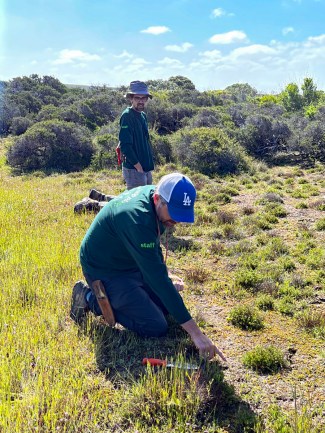Rare Native California Plant Species Rediscovered in Santa Barbara County
Team of Botanists Find Santa Ynez Groundstar on Vandenberg Space Force Base

A rare native California plant species was recently rediscovered after having been missing in action for nearly 30 years. Judging by how small the Santa Ynez groundstar (Ancistrocarphus keilii) is, it’s a miracle it was ever discovered in the first place.
Anyone who catches a glimpse of the tiny plant will merely see a little green speck of rosette buds and tendrils poking out of the dirt. You’d have to be a dedicated botanist to ever hope to notice it, as it’s smaller than a penny.
“Most people would probably walk right over them,” said Santa Barbara Botanic Garden systematist and herbarium curator Dr. Matt Guilliams, who played an essential role in finding the plant. “So you have to be there at just the right time, and you have to be looking hard.”

The one and only known population of the plant was located on the Vandenberg Space Force Base (VSFB) by a team of botanists from the Botanic Garden and California Native Plant Society (CPNS). Prior to the groundstar coming out of hiding, it was only known from very old records and one or two occurrences.
In the earliest reports of the species, only two scientists documented it formally, once in 1979 and again in 1995. But both times, it was misidentified, masquerading under a different name.
Few living botanists had ever even seen the plant in the wild before it was classified as a new and distinct species in 2004. When it was recognized as a new species, it was done so from the analysis of dried specimens, which the Botanic Garden said is often how new species are discovered.
“Plants such as this are or could be on the brink of extinction, and we can only confidently say they are doing okay once we get eyes on the ground and find them,” said CNPS Rare Plant Program Director Aaron Sims.
“Even though this species has been found, the population is extremely limited, and it’s important that land use changes do not occur.”
To find the miniscule plant, collaborators from CPNS and the Botanic Garden pieced together information from old records and primary sources as if searching for a long-lost artifact. Through their efforts, they were able to obtain a search permit for VSFB, where the little hidden treasure was known to have existed.
VFSB botanist Luanne Lum helped coordinate the search effort. Location information provided by Dr. Dieter Wilken, a retired research associate with Santa Barbara Botanic Garden, made the relocation relatively easy, the team said.
Once they were on VFSB, it took all of about five minutes to find it. However, Wilken started looking for the plant back in 1999, and again in 2011.
Sign up for Indy Today to receive fresh news from Independent.com, in your inbox, every morning.
Wilken actually did find it, but wasn’t sure at the time that he had found it, so he wrote down the location, and that’s what the Botanic Garden and CPNS botanists used to track it down, Guilliams said.
“I’m kind of a biodiversity geek, so anytime I meet a new kind of plant, it’s always really exciting,” Guilliams told the Independent. “But this species in particular, to know that this plant just grows on, as far as we know, just one place on Earth — it makes it really, really special to have been on Vandenberg and see this plant with some of my botanist friends.”
The Santa Ynez groundstar is part of the daisy (Asteraceae) family and blooms annually between March and April, according to the CPNS Rare Plant Inventory. Added to the list in 2005, the groundstar is one of the more than 200 rare plant species in Santa Barbara County alone.
Although botanists were thrilled to find it, there’s more to the little groundstar than what meets the eye. The team’s job now is to search for new populations so they can study and learn more about its role in nature and how to protect it.
“The vast majority of life on the planet are really tiny things, things that are not in the scale of human perception, that do really important jobs for us, and for the ecosystem as a whole,” Guilliams explained.
“We really have no idea what this little ground star is doing in nature. But the vast majority of living things are tiny things just like this plant, and we have no idea what their role is, but they play one.”
Work to update outdated plant occurrence data can require significant effort and research, but they are key to informing conservation efforts and staving off species extinction, the Botanic Garden said. A recent report by NatureServe found that 34 percent of plants in the United States are now at risk of extinction, with plants in California among the most at risk.

“By bringing attention to them, gathering new data, and fostering conservation attention and action, these species have a fighting chance of survival,” added Sims.
New specimens of the groundstar were collected by Guilliams and colleagues, and will be deposited at four regional herbaria: Santa Barbara Botanic Garden, Hoover Herbarium at California Polytechnic State University in San Luis Obispo, California Botanic Garden Herbarium, and the herbarium at VSFB.
The team is also updating population data as it turns toward conservation and seed banking of the species.
The full team of collaborators included CNPS Rare Plant Program Manager Kristen Nelson, Santa Barbara Botanic Garden Ken and Shirley Tucker Systematist and Clifton Smith Herbarium Curator Dr. Matt Guilliams, Santa Barbara Botanic Garden Rare Plant Techs Sean Carson and Kevin Mason, and Center for Environmental Management of Military Lands Lead Botanist Dr. Sarah DeGroot.




You must be logged in to post a comment.